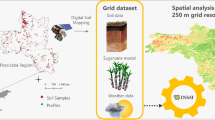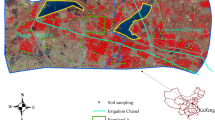Abstract
Digital soil mapping (DSM) is gaining momentum as a technique to help smallholder farmers secure soil security and food security in developing regions. However, communications of the digital soil mapping information between diverse audiences become problematic due to the inconsistent scale of DSM information. Spatial downscaling can make use of accessible soil information at relatively coarse spatial resolution to provide valuable soil information at relatively fine spatial resolution. The objective of this research was to disaggregate the coarse spatial resolution soil exchangeable potassium (Kex) and soil total nitrogen (TN) base map into fine spatial resolution soil downscaled map using weighted generalized additive models (GAMs) in two smallholder villages in South India. By incorporating fine spatial resolution spectral indices in the downscaling process, the soil downscaled maps not only conserve the spatial information of coarse spatial resolution soil maps but also depict the spatial details of soil properties at fine spatial resolution. The results of this study demonstrated difference between the fine spatial resolution downscaled maps and fine spatial resolution base maps is smaller than the difference between coarse spatial resolution base maps and fine spatial resolution base maps. The appropriate and economical strategy to promote the DSM technique in smallholder farms is to develop the relatively coarse spatial resolution soil prediction maps or utilize available coarse spatial resolution soil maps at the regional scale and to disaggregate these maps to the fine spatial resolution downscaled soil maps at farm scale.









Similar content being viewed by others
References
Arrouays, D., Grundy, M. G., Hartemink, A. E., Hempel, J. W., Heuvelink, G. B. M., Hong, S. Y., et al. (2014). Chapter Three—GlobalSoilMap: Toward a fine-resolution global grid of soil properties. In Donald L. Sparks (Ed.), Advances in Agronomy (Vol. 125, pp. 93–134). Academic Press. http://www.sciencedirect.com/science/article/pii/B9780128001370000030. Accessed 16 August 2014.
Brus, D. J., Orton, T. G., Walvoort, D. J. J., Reijneveld, J. A., & Oenema, O. (2014). Disaggregation of soil testing data on organic matter by the summary statistics approach to area-to-point kriging. Geoderma, 226–227, 151–159. https://doi.org/10.1016/j.geoderma.2014.02.011.
Castrignanò, A., Wong, M. T. F., Stelluti, M., De Benedetto, D., & Sollitto, D. (2012). Use of EMI, gamma-ray emission and GPS height as multi-sensor data for soil characterisation. Geoderma, 175–176, 78–89. https://doi.org/10.1016/j.geoderma.2012.01.013.
Chakrabarti, S., Bongiovanni, T., Judge, J., Nagarajan, K., & Principe, J. C. (2015). Downscaling satellite-based soil moisture in heterogeneous regions using high-resolution remote sensing products and information theory: a synthetic study. IEEE Transactions on Geoscience and Remote Sensing, 53(1), 85–101. https://doi.org/10.1109/TGRS.2014.2318699.
Goovaerts, P. (2010). Combining areal and point data in geostatistical interpolation: applications to soil science and medical geography. Mathematical Geosciences, 42(5), 535–554. https://doi.org/10.1007/s11004-010-9286-5.
Hartemink, A. E., Krasilnikov, P., & Bockheim, J. G. (2013). Soil maps of the world. Geoderma, 207–208, 256–267. https://doi.org/10.1016/j.geoderma.2013.05.003.
Hastie, T. J., & Tibshirani, R. J. (1990). Generalized Additive Models. CRC Press.
Karnieli, A. (1997). Development and implementation of spectral crust index over dune sands. International Journal of Remote Sensing, 18(6), 1207–1220.
Kaufman, Y. J., & Tanré, D. (1996). Strategy for direct and indirect methods for correcting the aerosol effect on remote sensing: from AVHRR to EOS-MODIS. Remote Sensing of Environment, 55(1), 65–79.
Kerry, R., Goovaerts, P., Rawlins, B. G., & Marchant, B. P. (2012). Disaggregation of legacy soil data using area to point kriging for mapping soil organic carbon at the regional scale. Geoderma, 170, 347–358. https://doi.org/10.1016/j.geoderma.2011.10.007.
Kim, G., & Barros, A. P. (2002). Downscaling of remotely sensed soil moisture with a modified fractal interpolation method using contraction mapping and ancillary data. Remote Sensing of Environment, 83(3), 400–413. https://doi.org/10.1016/S0034-4257(02)00044-5.
Krom, M. D. (1980). Spectrophotometric determination of ammonia: a study of a modified Berthelot reaction using salicylate and dichloroisocyanurate. Analyst, 105(1249), 305–316. https://doi.org/10.1039/AN9800500305.
Kursa, M. B., & Rudnicki, W. R. (2010). Feature selection with the Boruta package.
Kyriakidis, P. C. (2004). A geostatistical framework for area-to-point spatial interpolation. Geographical Analysis, 36(3), 259–289. https://doi.org/10.1111/j.1538-4632.2004.tb01135.x.
Liu, Y., & Journel, A. G. (2009). A package for geostatistical integration of coarse and fine scale data. Computers & Geosciences, 35(3), 527–547. https://doi.org/10.1016/j.cageo.2007.12.015.
Liu, D., & Pu, R. (2008). Downscaling thermal infrared radiance for subpixel land surface temperature retrieval. Sensors, 8(4), 2695–2706. https://doi.org/10.3390/s8042695.
Lobell, D. B., Burke, M. B., Tebaldi, C., Mastrandrea, M. D., Falcon, W. P., & Naylor, R. L. (2008). Prioritizing climate change adaptation needs for food security in 2030. Science, 319(5863), 607–610. https://doi.org/10.1126/science.1152339.
Malone, B. P., McBratney, A. B., & Minasny, B. (2013). Spatial scaling for digital soil mapping. Soil Science Society of America Journal, 77(3), 890. https://doi.org/10.2136/sssaj2012.0419.
Malone, B. P., McBratney, A. B., Minasny, B., & Wheeler, I. (2012). A general method for downscaling earth resource information. Computers & Geosciences, 41, 119–125. https://doi.org/10.1016/j.cageo.2011.08.021.
Malone, B. P., Styc, Q., Minasny, B., & McBratney, A. B. (2017). Digital soil mapping of soil carbon at the farm scale: a spatial downscaling approach in consideration of measured and uncertain data. Geoderma, 290, 91–99. https://doi.org/10.1016/j.geoderma.2016.12.008.
McBratney, A. B. (1998). Some considerations on methods for spatially aggregating and disaggregating soil information. Nutrient Cycling in Agroecosystems, 50(1–3), 51–62. https://doi.org/10.1023/A:1009778500412.
Nachtergaele, F., Van Velthuizen, H., Verelst, L., Batjes, N., Dijkshoorn, K., Van Engelen, V., et al. (2008). Harmonized world soil database. Food and Agriculture Organization of the United Nations.
Odgers, N. P., Libohova, Z., & Thompson, J. A. (2012). Equal-area spline functions applied to a legacy soil database to create weighted-means maps of soil organic carbon at a continental scale. Geoderma, 189–190, 153–163. https://doi.org/10.1016/j.geoderma.2012.05.026.
Odgers, N. P., Sun, W., McBratney, A. B., Minasny, B., & Clifford, D. (2014). Disaggregating and harmonising soil map units through resampled classification trees. Geoderma, 214–215, 91–100. https://doi.org/10.1016/j.geoderma.2013.09.024.
Ouyang, W., Xu, Y., Hao, F., Wang, X., Siyang, C., & Lin, C. (2013). Effect of long-term agricultural cultivation and land use conversion on soil nutrient contents in the Sanjiang Plain. Catena, 104, 243–250. https://doi.org/10.1016/j.catena.2012.12.002.
Pardo-Igúzquiza, E., Chica-Olmo, M., & Atkinson, P. M. (2006). Downscaling cokriging for image sharpening. Remote Sensing of Environment, 102(1–2), 86–98. https://doi.org/10.1016/j.rse.2006.02.014.
Sreedevi, T., Shiferaw, B., & Wani, S. (2004). Adarsha Watershed in Kothapally Understanding the Drivers of Higher Impact: Global Theme on Agroecosystems Report no. 10.
Subburayalu, S. K., Jenhani, I., & Slater, B. K. (2014). Disaggregation of component soil series on an Ohio County soil survey map using possibilistic decision trees. Geoderma, 213, 334–345. https://doi.org/10.1016/j.geoderma.2013.08.018.
Taylor, J. A., Jacob, F., Galleguillos, M., Prévot, L., Guix, N., & Lagacherie, P. (2013). The utility of remotely-sensed vegetative and terrain covariates at different spatial resolutions in modelling soil and watertable depth (for digital soil mapping). Geoderma, 193–194, 83–93. https://doi.org/10.1016/j.geoderma.2012.09.009.
Thomas, G. W. (1982). Exchangeable cations. Methods of soil analysis. Part 2. Chemical and microbiological properties, (methodsofsoilan2), 159–165.
Truong, P. N., Heuvelink, G. B. M., & Pebesma, E. (2014). Bayesian area-to-point kriging using expert knowledge as informative priors. International Journal of Applied Earth Observation and Geoinformation, 30, 128–138. https://doi.org/10.1016/j.jag.2014.01.019.
Wiggins, S., Kirsten, J., & Llambí, L. (2010). The future of small farms. World Development, 38(10), 1341–1348. https://doi.org/10.1016/j.worlddev.2009.06.013.
Xu, Y., Smith, S. E., Grunwald, S., Abd-Elrahman, A., & Wani, S. P. (2017a). Incorporation of satellite remote sensing pan-sharpened imagery into digital soil prediction and mapping models to characterize soil property variability in small agricultural fields. ISPRS Journal of Photogrammetry and Remote Sensing, 123, 1–19. https://doi.org/10.1016/j.isprsjprs.2016.11.001.
Xu, Y., Smith, S. E., Grunwald, S., Abd-Elrahman, A., & Wani, S. P. (2017b). Evaluating the effect of remote sensing image spatial resolution on soil exchangeable potassium prediction models in smallholder farm settings. Journal of Environmental Management, 200, 423–433. https://doi.org/10.1016/j.jenvman.2017.06.017.
Acknowledgements
This work is supported by the grant award no. 1201943 “Development of a Geospatial Soil-Crop Inference Engine for Smallholder Farmers” EAGER National Science Foundation and Research Foundation for Youth Scholars of Beijing Technology and Business University. The soil analysis was performed in the soil laboratory at the International Crops Research Institute for the Semi-Arid Tropics (ICRISAT) in Patancheru/Hyderabad, India. We thank Christopher M. Clingensmith at the University of Florida, and ICRISAT staff members and villagers of Kothapally and Masuti for the support with field sampling. We also thank Yiming Xu’s PhD committee member Dr. Thomas K. Frazer for his commitment and guidance. A matching assistantship for Yiming Xu was provided by the School of Natural Resources and Environment, University of Florida, and China Scholarship Council.
Author information
Authors and Affiliations
Corresponding author
Rights and permissions
About this article
Cite this article
Xu, Y., Smith, S.E., Grunwald, S. et al. Spatial downscaling of soil prediction models based on weighted generalized additive models in smallholder farm settings. Environ Monit Assess 189, 502 (2017). https://doi.org/10.1007/s10661-017-6212-z
Received:
Accepted:
Published:
DOI: https://doi.org/10.1007/s10661-017-6212-z




